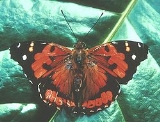
Ditrysia
Encyclopedia
The Ditrysia are a natural group or clade
of insects in the Lepidoptera
n order containing both butterflies
and moth
s. They are so named because the female has two distinct sexual openings: one for mating
, and the other for laying eggs
(in contrast to the Monotrysia
).
About 98% of described
species of Lepidoptera belong to Ditrysia. The group can be divided into basal
or incertae sedis
"micromoths" and the Apoditrysia, which includes mostly larger moths as well as the butterflies. Those with a dorsal heart vessel belong in section Cossina
. Others, having a ventral heart vessel belong in section Tineina.
Cladistics
Cladistics is a method of classifying species of organisms into groups called clades, which consist of an ancestor organism and all its descendants . For example, birds, dinosaurs, crocodiles, and all descendants of their most recent common ancestor form a clade...
of insects in the Lepidoptera
Lepidoptera
Lepidoptera is a large order of insects that includes moths and butterflies . It is one of the most widespread and widely recognizable insect orders in the world, encompassing moths and the three superfamilies of butterflies, skipper butterflies, and moth-butterflies...
n order containing both butterflies
Butterfly
A butterfly is a mainly day-flying insect of the order Lepidoptera, which includes the butterflies and moths. Like other holometabolous insects, the butterfly's life cycle consists of four parts: egg, larva, pupa and adult. Most species are diurnal. Butterflies have large, often brightly coloured...
and moth
Moth
A moth is an insect closely related to the butterfly, both being of the order Lepidoptera. Moths form the majority of this order; there are thought to be 150,000 to 250,000 different species of moth , with thousands of species yet to be described...
s. They are so named because the female has two distinct sexual openings: one for mating
Mating
In biology, mating is the pairing of opposite-sex or hermaphroditic organisms for copulation. In social animals, it also includes the raising of their offspring. Copulation is the union of the sex organs of two sexually reproducing animals for insemination and subsequent internal fertilization...
, and the other for laying eggs
Egg (biology)
An egg is an organic vessel in which an embryo first begins to develop. In most birds, reptiles, insects, molluscs, fish, and monotremes, an egg is the zygote, resulting from fertilization of the ovum, which is expelled from the body and permitted to develop outside the body until the developing...
(in contrast to the Monotrysia
Monotrysia
The Monotrysia is a group of insects in the Lepidopteran order which is not currently considered to be a natural group or clade. The group contains only moths and most of these are small and are relatively understudied in many regions of the world...
).
About 98% of described
Binomial nomenclature
Binomial nomenclature is a formal system of naming species of living things by giving each a name composed of two parts, both of which use Latin grammatical forms, although they can be based on words from other languages...
species of Lepidoptera belong to Ditrysia. The group can be divided into basal
Basal (phylogenetics)
In phylogenetics, a basal clade is the earliest clade to branch in a larger clade; it appears at the base of a cladogram.A basal group forms an outgroup to the rest of the clade, such as in the following example:...
or incertae sedis
Incertae sedis
, is a term used to define a taxonomic group where its broader relationships are unknown or undefined. Uncertainty at specific taxonomic levels is attributed by , , and similar terms.-Examples:*The fossil plant Paradinandra suecica could not be assigned to any...
"micromoths" and the Apoditrysia, which includes mostly larger moths as well as the butterflies. Those with a dorsal heart vessel belong in section Cossina
Cossina
Cossina is the name for both a section and subsection of Ditrysian insects in order containing both butterflies and moths having a dorsal heart vessel...
. Others, having a ventral heart vessel belong in section Tineina.
Sources
- Kristensen, N. P. and Skalski, A.W. (1999). Phylogeny and paleontology. Pages 7-25 in: Lepidoptera: Moths and Butterflies. 1. Evolution, Systematics, and Biogeography. Handbook of Zoology Vol. IV, Part 35. N. P. Kristensen, ed. De Gruyter, Berlin and New York.
- Capinera, John, editor (2008), Encyclopedia of Entomology, 2nd ed., Springer Verlag, New York.

